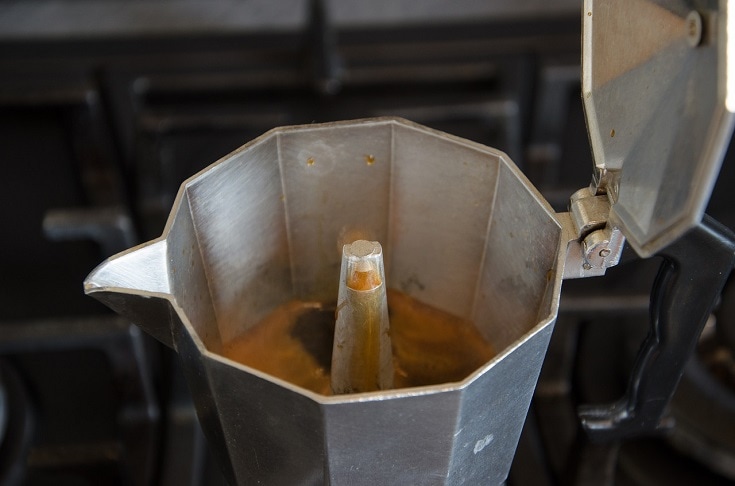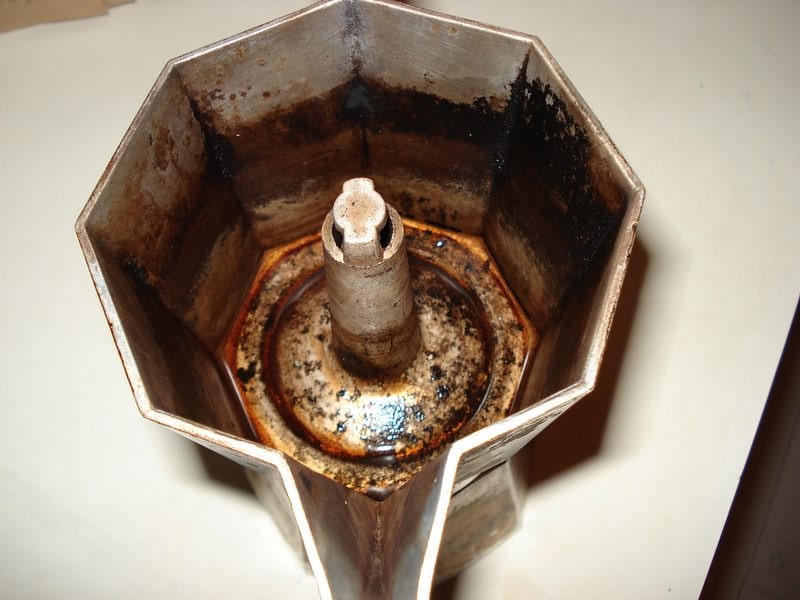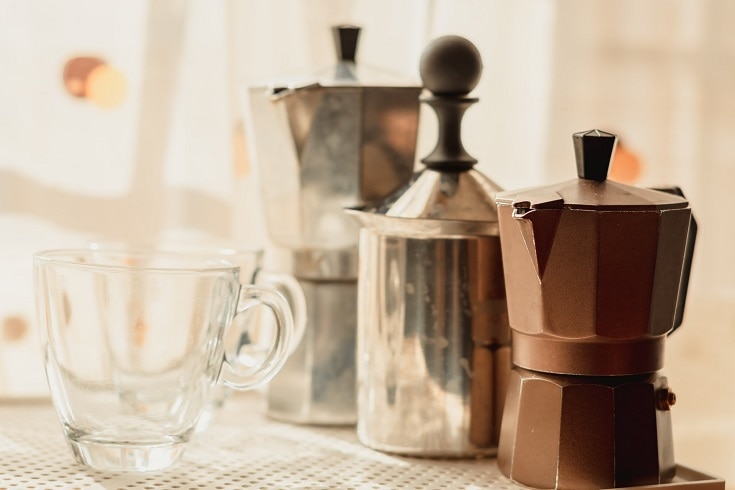
Keeping your coffee equipment clean is critical if you want to make consistently excellent coffee, regardless of what brewing method you use. But If you use a Moka pot, keeping it squeaky clean is even more important since a dirty Moka pot is a ticking time bomb – literally. Because Moka pots create a high-pressure environment in their bottom chambers, you need to make sure you keep the safety release valve free of gunk and grime to avoid dangerous and messy explosions.
In this article, we’re going to teach you how to ensure the safety and quality of your Moka pot with a quick and simple Moka pot cleaning regimen. A few minutes of work goes a long way to keeping your coffee delicious and your kitchen explosion-free.

The Dangers of a Dirty Moka Pot
Moka pots brew coffee by forcing water through finely-ground beans, much like espresso makers. When the water in a Moka pot boils, steam starts to fill the bottom chamber, increasing the pressure. Once the pressure is high enough, water starts to pass through the coffee grounds, extracting flavor as it goes.
Whenever pressure builds up, the possibility of an explosion exists. Moka pots alleviate this concern by including a safety valve on the pressurizing chamber so that steam can escape if the pressure gets too high. Most of the time, this works like a charm, and you don’t have to worry about accidentally creating a coffee bomb on your stovetop. However, if you don’t clean your Moka pot thoroughly, the safety valve can clog, and the chances of an explosion increase.

Why Does The Safety Valve Clog?
There are two main ways the safety valve on your Moka pot can clog. The first – and the most obvious – way is from coffee residue and old grounds. Moka pots use fine coffee grounds that can easily get lodged in the safety valve. If enough grounds get stuck in the valve, it can become entirely blocked.
Mineral deposits can also block the safety valve if you don’t regularly descale your Moka pot. Some areas have what’s called “hard water,” water with a higher concentration of calcium and magnesium than normal. If you notice your sinks and bathtub build up a white residue around the drains, you live in an area with hard water. The white residue is mostly calcium that stays behind and clings to surfaces after the water has drained and evaporated.
Hard water can be a nuisance, but it is easy to deal with calcium buildup using only common household ingredients. First, we’ll give you a simple everyday cleaning process to follow before discussing how to remove calcium deposits by descaling your Moka pot.

How To Clean Your Moka Pot
Let’s begin by discussing a brief routine that you should perform every time you use your Moka pot. Taking these few small steps after each use will help keep your Moka pot clean and safe to use, and they don’t take a lot of time or effort.
Start by thoroughly rinsing your Moka pot after it has cooled off and is safe to handle. Pay special attention to the filter basket since ground can easily get stuck in the holes. A quick visual inspection is enough to ensure there are no stragglers left in the bottom chamber or lodged in the safety valve.
Unfortunately, most Moka pots are aluminum and, therefore, are prone to rust. Make sure all parts of your Moka pot are dried completely before you reassemble it and put it away. Many Moka pots also have a thin coating inside that prevents your coffee from tasting metallic, meaning you shouldn’t put it in the dishwasher. You also shouldn’t scrub your Moka pot with anything other than a soft sponge or brush. Otherwise, you risk removing the protective coating over time.
Taking the few minutes necessary to rinse and dry your Moka pot after every use is a great way to make sure your Moka pot stays safe to use and continues to make tasty coffee.

How To Descale Your Moka Pot
Regularly cleaning your Moka pot is important, but so is occasionally descaling it, especially if you live in an area with hard water. Thankfully, you don’t have to descale very often; every few months is usually enough.
Before you start, make sure you have these simple ingredients and enough time:
- 1 tablespoon vinegar
- 1 tablespoon lemon juice
- About 3 hours (don’t worry, you only need to be actively involved for about 10 minutes)

1. Fill the bottom chamber with water.
Add water to your Moka pot’s brewing chamber until it is almost filled. Leave just enough room to add 1 tablespoon each of vinegar and lemon juice.
2. Add the vinegar and lemon juice.
Add both ingredients to the water and give the mixture a quick stir.
3. Let it sit for about 3 hours.
Let the water-acid mixture soak for at least two hours. After four hours, you get diminishing returns. Three hours is the sweet spot.
4. Dump some liquid out.
After three hours, dump out enough mixture so that the safety valve is above the waterline.
5. Run a brew cycle.
Attach the brew chamber to the top of the Moka pot and put it on the stove. Run a brew cycle as if you were making a cup of coffee.
6. Rinse everything thoroughly.
After the brew cycle finishes and the Moka pot is cool to the touch, give everything a good rinse. We like to run a few brew cycles with only water to eliminate any residual vinegar and lemon juice flavors.

Keeping Moka Pots Clean: Final Thoughts
Moka pots make delicious, strong coffee thanks to the high-pressure brewing approach. Most of the time, Moka pots are perfectly safe, but if you neglect yours and don’t clean and descale it regularly, you could wind up with a dangerously over-pressurized stovetop bomb. Luckily, cleaning and descaling your Moka pot is easy and doesn’t take much time.
We hope you found this guide helpful! If you follow these simple tips, you don’t have to worry about coffee explosions and can enjoy your Moka pot coffee in peace.
Featured Image Credit: Kaffeetastisch, Pixabay
















